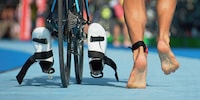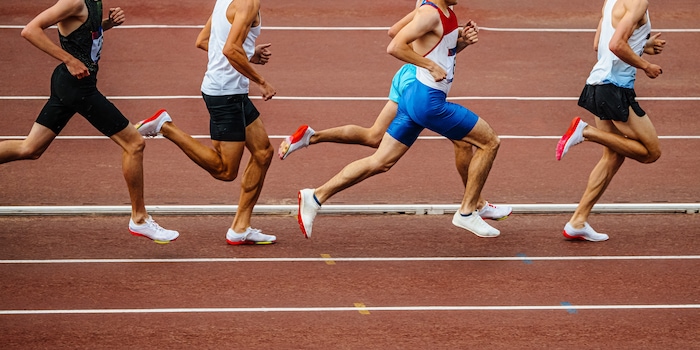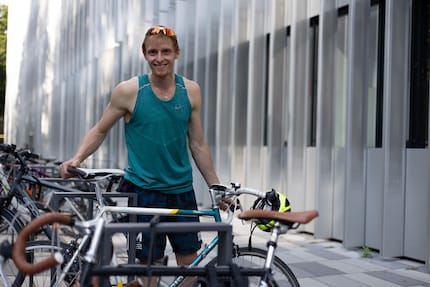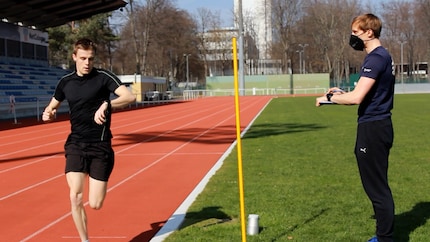
Background information
Why maximal oxygen uptake is more important when cycling than running
by Michael Restin

In endurance sports, you need the perfect mix of race strategy, stamina and sprinting qualities. In other words: the right metabolic profile for the competition course. Dr Oliver Quittmann looks for crucial differences and investigates whether there is still room for improvement in performance diagnostics in running.
Oxygen is the substance that is particularly important in endurance sports. More precisely: how it is handled. The body's ability to metabolise it and provide energy in this way is crucial. That is why the maximum oxygen uptake (VO₂max) is the most important parameter, which is accordingly the focus of performance diagnostics. But by far not the only one. "In general, I would find it exciting to see the glycolytic aspect increasingly included in studies as well," says sports scientist Dr Oliver Quittmann from the German Sport University Cologne when I ask him about the present and future of performance diagnostics.

The glycolytic system always comes into play when an extra portion of energy is needed. The anaerobic metabolic process runs without oxygen and quickly supplies a lot of adenosine triphosphate (ATP) per time, the fuel of the muscles. However, lactate is also formed in the process. A molecule that used to be considered a "breakdown product", but is now known to be an important energy carrier and trigger of training stimuli. In the course of many fast contractions, however, hydrogen ions (H+) can also be produced, which at some point, if too high, will slow us down. No problem, as long as it happens after the final sprint to the finish. But fatal if the performance slump comes before the end of the race.
Athletes try to maximise performance according to their goals. "Depending on the competition distance, the priorities shift," Quittmann explains. "In the field of middle distance or long sprint, the glycolytic system is an important factor alongside the oxidative system."
What Quittmann and the performance diagnostics scene are specifically interested in in this context is called maximum lactate formation rate (ċLamax): "It stands for the performance of the glycolytic system, for anaerobic power."
Those who achieve high values can put a lot of energy on the track or on the pedal in a short time..
Long-distance athletes are more interested in lowering the maximum lactate production rate and optimising the oxidative system. But in practice, it is often a combination of abilities that counts and should be considered accordingly in performance diagnostics. "One aspect that we know from cycling and that we have transferred to running is that we look at how the body reacts in terms of the production of lactate during a very short load of about ten seconds," Quittmann explains. "The warm-up is followed by a 100-metre sprint and we look at how the lactate concentration rises."
Combined with other tests, this reveals the individual metabolic profile - a complex view of the athletes' overall metabolism.
To be able to comprehensively assess this overall picture, Quittmann and his team had 44 ambitious athletes complete four tests in one week: these included a submaximal step test on the treadmill, a ramp test on the treadmill, a maximal sprint test over 100 m and a 5000 m run at the performance limit on the track.
The sprint test maps glycolytic performance. The treadmill tests provide information about aerobic performance. And in the 5000 m run, the pacing strategy of the test persons was also put under the microscope. With the aim of getting the maximum out of individual conditions, the race strategy must ultimately fit the individual performance in the respective discipline. Only those who know their body and its limits under the given conditions can plan their race according to their own strengths.
"To capture pacing, all I need is a stopwatch, then I can look at split times," says the performance diagnostician. "And how this pacing relates to physiology I think is a very exciting topic."
In the 5000 metres on the track, both the glycolytic and oxidative systems are heavily challenged and differences in race splitting are revealed.

"We looked at which pacing profiles presented themselves as part of a cluster analysis and found three different ones," says Quittmann. "In cluster A, the start was not overly fast, but the athletes got faster and faster as they went along and there was still a 'finishing kick' - the speed increased extremely before the finish."
So these were the athletes with the strongest spurts. "In cluster B it was almost the other way round with a fast start and tending to slow down, but at the end it went up to a similar level as in cluster A," Quittmann continues. Fast starters with a decent finish. "Then there was cluster C, also with a fast start, dropping off and no final spurt." That's what it looked like on the track. And what did the metabolic profile show?
"We compared all possible variables and racked our brains as to what differentiated clusters A and C," the performance diagnostician sets about explaining. "There was no significant difference in either oxygen uptake, running time or post-exercise lactate concentration," which is not to be confused with maximum lactate formation rate, which is about energy flow. Post-exercise lactate concentration also has a motivational component. If you give it your all, you will reach high levels.
"The only difference was that the lactate formation rate was significantly greater in cluster A than in cluster C," says Quittmann. "We believe - and this is where it gets very exciting - if I have a high lactate build-up and can produce a lot, then I can't afford to have a high speed early in the race, so to speak," because that could have negative consequences. "If I get into that lactate formation relatively quickly, there are other factors associated with that, such as accumulating H+ ions, which lead to muscular fatigue."
So the final sprinters couldn't help but start off cautiously. "The evaluation of a second study is still pending and the expert is accordingly cautious: "I would assume that there are correlations between physiological profile and pacing." There is no doubt that such a look at the overall metabolism is interesting, but it is time-consuming. Quittmann's talk at the "Sience Slam", which you can see in the video below, on the other hand, is entertaining, informative and entertaining.
What the sports scientist explains simply is anything but easy to grasp. Optimising performance diagnostics in running therefore also means: reducing the effort. For example, by using mathematical models to achieve the goal. What can be simulated does not have to be completed as an elaborate test. But only if the assumed correlations match the measured data.
"Mathematically, the ratio of oxygen uptake to lactate formation rate explains the percentage exhaustion at the maximum lactate steady state," says the expert. This brings another important parameter into play: at the maximum lactate steady state, lactate formation and degradation are just about in balance. The body is at its limit in terms of endurance performance.
"Through simulation aspects, you can try to bring all the values together," says Quittmann. Together with colleagues, he has put a mathematical assumption to the test. What makes sense mathematically, however, does not stand up to comparison with the measured data. It seems that correlations that might exist in cycling cannot be transferred to running and expressed in a model. "We have investigated whether the maximum lactate formation rate is a reliable measure. But even if we use the best possible tests, we don't have satisfactory results as far as running is concerned."
The comparison shows that the two sports are each a world apart. "If I do a diagnostic with lactate formation rate as a parameter for glycolytic performance in cycling, it does not mean that I have a similar value in running or that these correlate with each other," emphasises Quittmann, who as a triathlete himself is active in both endurance disciplines. To put it simply: "It is possible that someone can produce a relatively high amount of lactate in running, but not in cycling". For ambitious triathletes, this means that they have to show up for performance diagnostics in both disciplines. The only question is to which test procedures.
Quittmann feels it is important to point out the different schools of performance diagnostics. "There are also completely different concepts that don't measure so much lactate or oxygen uptake and deal with 'critical power' or 'critical velocity'," which are two values that can be determined relatively easily without breathing gas or blood analyses. "Critical power" in cycling, "critical velocity" in running. "For this, you do several time trials of two to a maximum of 20 minutes and calculate a continuous power."
.
Also in this way it is possible to determine a maximum power or speed that can be achieved permanently - and thus should correspond to the maximum lactate steady state. However, it does not seem to be quite like that (at least for running). "The first results in the comparison show that the 'critical velocity' is always significantly higher than at the maximum lactate steady state," says Quittmann. "We and also others are of the opinion: this method is perhaps more practicable, but not better." From whichever perspective you look at it - there is still a lot to be researched, compared and seemingly secured knowledge questioned. Research is also clearly an endurance discipline.
Dr Oliver Quittmann researches and teaches at the German Sport University Cologne, among other things in the field of endurance sports. In his studies, he deals with various methods of performance diagnostics, primarily investigating glycolytic metabolism. In addition to his work, the 31-year-old runs the video podcast "Exercise Inside Out" and communicates his research results in science slams. He regularly publishes much of his teaching and research content on his YouTube channel.
Titelbild: Shutterstock
Simple writer and dad of two who likes to be on the move, wading through everyday family life. Juggling several balls, I'll occasionally drop one. It could be a ball, or a remark. Or both.
Interesting facts about products, behind-the-scenes looks at manufacturers and deep-dives on interesting people.
Show all
Background information
by Michael Restin

Background information
by Siri Schubert

Background information
by Siri Schubert